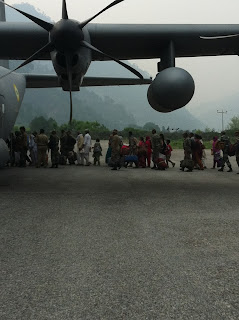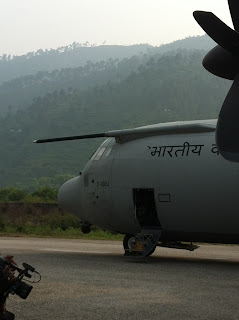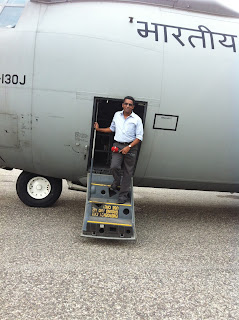 In a very innovative, yet daring move, the IAF today virtually established an aviation fuel supply bridge at Dharasu to give greater impetus to rescue operations which were severely restricted due to non availability of aviation fuel in the upper reaches of Uttarakhand.
In a very innovative, yet daring move, the IAF today virtually established an aviation fuel supply bridge at Dharasu to give greater impetus to rescue operations which were severely restricted due to non availability of aviation fuel in the upper reaches of Uttarakhand.With the road connectivity to Uttarkashi completely broken down, bad weather adversely affecting launch of flying operations from Jollygrant airfield of Dehradun and under the renewed threat of bad weather likely to hit the state on on 24 June, there was no way out but to think of an out of the box solution with a singular aim of continued rescue operations.
Going by the lay of the land it was decided to examine the possibility of using the small air strip at Dharasu to establish a forward launch base for rescue operations. However, apart from weather, challenges were many. The length of the air strip was only 1300 meters, the mountainous terrain posed a great danger to the Aircraft making an approach for landing in the prevalent inclement weather conditions.
Moreover there was no infrastructure to support flying operations of the sophisticated aircraft like the C-130 J at Dharasu. But with a true professional approach and calculated risk management a decision was taken to go ahead with theidea.
After a quick SWOT analysis of terrain, weather and capability of aircraft and aircrew, the the aircraft was launched from Hindan air base and objective was achieved, despite the inclement weather, when the first C 130J aircraft made an historic landing at Dharasu in the early morning on 22 Jun 13.
In a first of its kind, after landing, the aircraft offloaded 8000 litres of fuel into an empty bowser, airlifted the previous day from Sarsawa by the heavy lift Mi 26 helicopter, which further put life into the helicopters which were starved of fuel till then.
 With the availability of fuel at Dharasu, rescue operations picked up pace and within no time commenced nonstop flights and by evening established a firm launch base.
With the availability of fuel at Dharasu, rescue operations picked up pace and within no time commenced nonstop flights and by evening established a firm launch base.  The C 130J crew was given a new task of airlifting the pilgrims from Dharasu to Hindan on their return trip. To start with, 35 stranded pilgrims, some of them needing immediate medical assistance, were put onboard and brought to Hindan. Having achieved the first objective, the IAF quickly embarked upon a mission to establish a virtual fuel supply bridge and use the return trips to rescue the stranded pilgrims into safer locations. The second trip off loaded 8000 kgs of fuel at Dharasu and picked up 101 passengers (80 adults+21children, including two on stretcher) and brought them back to Hindan.
The C 130J crew was given a new task of airlifting the pilgrims from Dharasu to Hindan on their return trip. To start with, 35 stranded pilgrims, some of them needing immediate medical assistance, were put onboard and brought to Hindan. Having achieved the first objective, the IAF quickly embarked upon a mission to establish a virtual fuel supply bridge and use the return trips to rescue the stranded pilgrims into safer locations. The second trip off loaded 8000 kgs of fuel at Dharasu and picked up 101 passengers (80 adults+21children, including two on stretcher) and brought them back to Hindan. Having transferred the required fuel at Dharasu, the third trip of the day was used to airlift the Medical Team of the IAF to provide immediate medical assistance to the needy passengers awaiting airlift at Dharasu itself. This writer and a cameraperson colleague was on this third flight.
22 June 2013 will remain a significant milestone in IAF’s history



June 23, 2013 -
Hearing of this remarkable feat of the IAF. I am very proud of being an Ex- IAF veteran aviator. I wish I could have participated in these relief operations today in rescuing so many of our countrymen and foreign tourists.
June 23, 2013 -
Very interested in knowing how the new Army Aviation birds, besides the trusted old alouettes, performed at altitude in Uttarakhand.
June 24, 2013 -
Nice write up…Nitin. The An-32s…way back during Op Pawan…. also did something similar by carrying fuel in flexible tanks positioned in the cargo compt for replenishing the stock at either Jaffna or Trinco…. I forget where. We took of from the main land…..this is also a regularly done by the IL76 at Leh during winters when the road are closed and fuel stocks touch red levels.
July 5, 2013 -
Well written, but didn't you highlighted the wrong aircraft for the refuelling missions? The C130J might have brought the fuel at the end, but it wasn't cleared for landing in the effected areas during the first days, that's why IAF used in recon roles only.It was the Mi 26 instead, that transported 30 barrels of fuel to Dharasu at first and kept the helicopter operations going on. Moreover, without the Mi 26 carrying the fuel bowser's to the air strips later, the C130J wouldn't be able to divert the fuel either! Both actually showed the importance of the Mi 26 for IAF's logistical roles in these mountain areas, because whenever there is a need of heavy lift capacity, but a lack of suitable airstrips for fixed winged aircraft's, it is the “only” option to transport such cargo or vehicles. For some reasons however it was just mentioned as a side note, while the C130J got the credit in the media.Regards